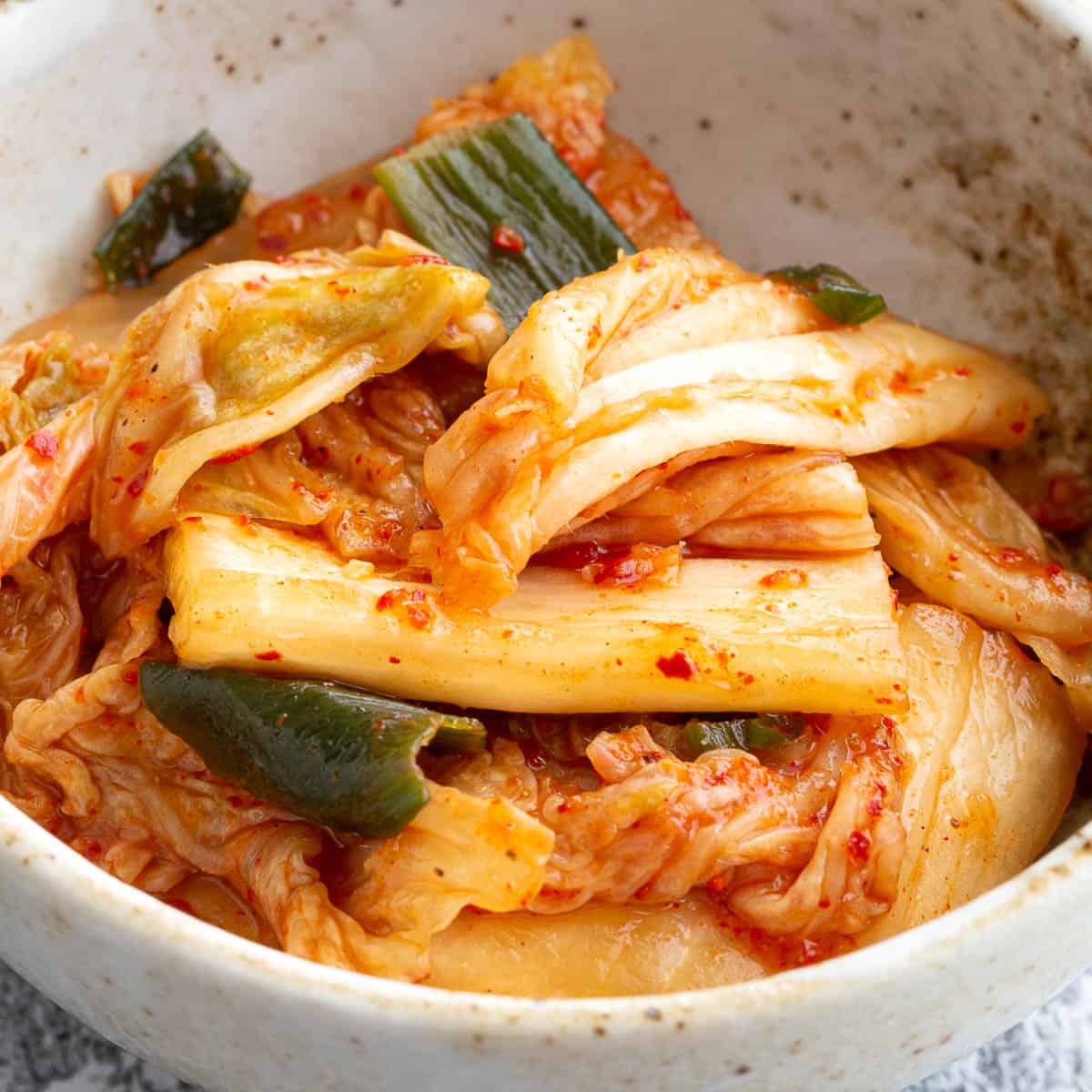A Dive into the World of Kimchi: From Spicy Ferment to Flavorful Dishes
Related Articles
- A Journey Through The Flavors Of Rendang: From Humble Beginnings To Global Fame
- A Journey Through Time: Exploring The Rich History And Delectable Flavors Of Beef Stroganoff
- A Culinary Journey Through Time: Exploring The Flavorful History Of Beef Tacos (México)
- A Bowl Of Comfort: Unveiling The Secrets Of Bubur Ayam
- Pasta Primavera: A Celebration Of Spring On Your Plate
Introduction
Welcome to our in-depth look at A Dive into the World of Kimchi: From Spicy Ferment to Flavorful Dishes
A Dive into the World of Kimchi: From Spicy Ferment to Flavorful Dishes

Kimchi, the iconic fermented cabbage dish of Korea, is more than just a side dish. It’s a cultural cornerstone, a testament to Korea’s culinary ingenuity, and a vibrant showcase of the power of fermentation. This article will take you on a journey through the fascinating world of kimchi, exploring its history, ingredients, fermentation process, variations, and culinary applications. We’ll delve into the techniques behind crafting delicious kimchi, equip you with tips for success, and inspire you to explore the endless possibilities of this versatile fermented treasure.
A History Steeped in Tradition
Kimchi’s origins are as rich as its flavor. While its exact beginnings are shrouded in history, evidence suggests it was already a staple in Korean cuisine as early as the 7th century. The name itself, "kimchi," is believed to have evolved from the word "gimchi," which referred to a preserved vegetable dish in ancient Korea.
The early forms of kimchi were likely simpler than today’s variations. With limited access to refrigeration, fermentation became essential for preserving vegetables, particularly during the harsh Korean winters. Over time, the process evolved, incorporating a wider range of ingredients and techniques, resulting in the vast array of kimchi varieties we know today.
The Power of Fermentation: A Culinary Alchemy
Fermentation is the heart and soul of kimchi. It’s the process that transforms simple ingredients into a complex, flavorful, and healthy dish. The magic happens when lactic acid bacteria, naturally present in the cabbage and other ingredients, begin to break down sugars, producing lactic acid and other compounds that contribute to kimchi’s distinctive sour, pungent, and umami notes.
The science behind the fermentation process:
- Lactic Acid Bacteria: These beneficial bacteria are the key players in fermentation. They convert sugars into lactic acid, which acts as a natural preservative, inhibiting the growth of harmful bacteria.
- Flavor Development: The fermentation process also creates a multitude of other flavor compounds, including acetic acid, carbon dioxide, and esters, which contribute to kimchi’s complex taste profile.
- Nutritional Enhancement: Fermentation not only enhances flavor but also increases the bioavailability of nutrients in the cabbage, making it easier for our bodies to absorb.

Unveiling the Essential Ingredients
The foundation of any kimchi recipe lies in its core ingredients:
- Napa Cabbage: This is the primary ingredient, providing the base for fermentation. Choose firm, fresh cabbage with crisp leaves.
- Gochugaru (Korean Chili Pepper Flakes): This is the source of kimchi’s signature heat and vibrant red color. Different varieties of gochugaru offer varying levels of heat and flavor, from mild to intensely spicy.
- Salt: Salt is crucial for drawing out moisture from the cabbage and creating an environment conducive to fermentation. It also adds a subtle savory note.
- Garlic and Ginger: These pungent aromatics add depth of flavor and a hint of warmth to the kimchi.
- Scallions: Scallions contribute a fresh, slightly oniony flavor and add a pleasing visual element.
- Fish Sauce (Optional): Fish sauce, traditionally used in Korean cuisine, adds a savory umami depth and a slightly fishy aroma.
- Other Ingredients: Depending on the specific kimchi variation, you might encounter ingredients like fermented seafood (saeujeot), radish, fermented soybean paste (doenjang), or even fruits like pears or apples.
The Art of Crafting Kimchi: A Step-by-Step Guide

Making kimchi is an enjoyable, rewarding process that allows you to personalize the flavors and textures to your liking. Here’s a basic recipe that provides a framework for creating your own delicious kimchi:
Ingredients:
- 1 head Napa cabbage (about 2 pounds)
- 1/2 cup gochugaru (adjust to your desired spice level)
- 1 tablespoon salt
- 4 cloves garlic, minced
- 1 tablespoon grated ginger
- 4 scallions, thinly sliced
- 1 tablespoon fish sauce (optional)
- 1/2 cup water
Instructions:
- Prepare the Cabbage: Cut the cabbage in half lengthwise, then slice it into thin strips.
- Salt the Cabbage: Sprinkle the cabbage generously with salt, ensuring all surfaces are coated. Massage the salt into the cabbage, helping it release its moisture.
- Rest the Cabbage: Place the salted cabbage in a large bowl and cover it with a plate weighted down with a heavy object (like a large jar filled with water). Let it sit for at least 2 hours, or until it has softened and released its liquid.
- Prepare the Kimchi Paste: In a separate bowl, combine the gochugaru, garlic, ginger, scallions, fish sauce (if using), and water. Mix well to form a thick paste.
- Mix the Cabbage and Paste: Drain the cabbage, removing any excess liquid. Then, add the kimchi paste to the cabbage and mix thoroughly, ensuring the paste coats the cabbage evenly.
- Pack the Kimchi: Transfer the kimchi into a clean, airtight container, pressing it down firmly to remove any air pockets.
- Ferment: Store the kimchi at room temperature for 1-2 days, or until it starts to bubble and develop a slightly sour aroma. Once fermented, transfer it to the refrigerator for longer storage.
Mastering the Techniques: Tips for Kimchi Success
- Cabbage Selection: Choose firm, fresh napa cabbage with crisp leaves. Avoid wilted or damaged cabbage.
- Salting Technique: Proper salting is crucial for drawing out moisture from the cabbage and creating an environment conducive to fermentation. Ensure all surfaces are evenly coated with salt and massage it well into the cabbage.
- Paste Consistency: The kimchi paste should be thick enough to coat the cabbage but not too thick to make it difficult to mix. Adjust the water content as needed.
- Fermentation Temperature: Room temperature (around 68-72°F) is ideal for kimchi fermentation. Avoid extreme temperatures, as they can affect the flavor and texture of the kimchi.
- Storage: Once fermented, store the kimchi in the refrigerator for longer storage. Kimchi can be stored in the refrigerator for several months.
Kimchi Variations: Exploring a World of Flavor
The beauty of kimchi lies in its endless variations. Here are some popular kimchi variations to inspire your culinary adventures:
- Baechu Kimchi (Napa Cabbage Kimchi): This is the most classic kimchi, featuring napa cabbage, gochugaru, garlic, ginger, and other spices. It’s a versatile kimchi that can be enjoyed with a wide range of dishes.
- Kkakdugi (Radish Kimchi): This kimchi features cubed radishes, gochugaru, garlic, and ginger. It has a slightly crunchy texture and a refreshing, tangy flavor.
- O-Kimchi (Cucumber Kimchi): This kimchi is made with cucumbers, gochugaru, garlic, ginger, and sometimes fermented seafood. It’s a refreshing and slightly salty kimchi.
- Chonggak Kimchi (Mustard Greens Kimchi): This kimchi features mustard greens, gochugaru, garlic, ginger, and often fermented seafood. It has a pungent, spicy flavor and a slightly bitter edge.
- Ggakdugi (Radish Kimchi): This kimchi features cubed radishes, gochugaru, garlic, and ginger. It has a slightly crunchy texture and a refreshing, tangy flavor.
- Pa Kimchi (Scallion Kimchi): This kimchi features scallions, gochugaru, garlic, ginger, and sometimes fish sauce. It’s a milder kimchi with a fresh, slightly oniony flavor.
- Oi Muchim (Cucumber Salad): While not strictly a kimchi, this refreshing salad features cucumbers, gochugaru, garlic, and ginger. It’s a great way to add a spicy kick to your meals.
Kimchi in Cuisine: A Culinary Star
Kimchi is far more than just a side dish. It’s a versatile ingredient that can elevate the flavors of countless dishes. Here are some ways to incorporate kimchi into your culinary repertoire:
- Traditional Korean Dishes: Kimchi shines in traditional Korean dishes like bibimbap (mixed rice with vegetables), kimchi jjigae (kimchi stew), and kimchi fried rice.
- Western Cuisine: Kimchi can add a unique twist to Western dishes. Try incorporating it into burgers, tacos, pizzas, or even pasta dishes.
- Snacks and Appetizers: Kimchi makes a delicious snack or appetizer. Enjoy it on its own, with rice, or as a topping for crackers or bread.
- Soups and Stews: Kimchi adds depth of flavor and a spicy kick to soups and stews. Use it in chicken, beef, or pork stews.
- Stir-fries and Noodles: Kimchi can be used to add a flavorful punch to stir-fries and noodle dishes. It pairs well with tofu, mushrooms, and other vegetables.
Beyond the Plate: The Health Benefits of Kimchi
Kimchi is not only delicious but also packed with health benefits. Its fermentation process creates a wealth of beneficial compounds that contribute to overall well-being:
- Probiotics: Kimchi is a rich source of probiotics, which are beneficial bacteria that support gut health. A healthy gut microbiome is linked to improved digestion, immune function, and mental health.
- Antioxidants: Kimchi is rich in antioxidants, which help protect cells from damage caused by free radicals. This can help reduce the risk of chronic diseases such as heart disease, cancer, and Alzheimer’s disease.
- Fiber: Kimchi is a good source of dietary fiber, which promotes digestive health and helps regulate blood sugar levels.
- Vitamins and Minerals: Kimchi is a good source of vitamins and minerals, including vitamin C, vitamin K, iron, and calcium.
Exploring the Culinary Landscape of Kimchi
Beyond the basic recipes and variations, the world of kimchi offers endless possibilities for culinary exploration. Here are some ideas to spark your creativity:
- Kimchi Fusion: Experiment with incorporating kimchi into dishes from different cuisines. Try making kimchi tacos, kimchi pizza, or kimchi pasta.
- Kimchi Dehydration: Dehydrate kimchi to create a concentrated, flavorful powder that can be used to season soups, stews, or sauces.
- Kimchi Relish: Make a kimchi relish by chopping kimchi and combining it with other ingredients like vinegar, sugar, and spices. Use it as a topping for burgers, hot dogs, or sandwiches.
- Kimchi Jam: Create a unique and flavorful jam by combining kimchi with fruits like peaches, plums, or apricots. Use it as a spread for toast, crackers, or even as a glaze for roasted meats.
- Kimchi Pickles: Make kimchi pickles by fermenting vegetables like cucumbers or carrots with kimchi paste.
Conclusion: A Culinary Journey Worth Embarking On
Kimchi is more than just a food; it’s a cultural treasure, a testament to culinary ingenuity, and a journey of flavor and health. From its humble beginnings as a means of preserving vegetables to its modern-day status as a global culinary star, kimchi continues to captivate taste buds and inspire culinary innovation. So, embark on your own kimchi journey. Experiment with different variations, explore its culinary possibilities, and discover the unique and delightful world of this fermented masterpiece.
Closure
We hope this article has helped you understand everything about A Dive into the World of Kimchi: From Spicy Ferment to Flavorful Dishes. Stay tuned for more updates!
Don’t forget to check back for the latest news and updates on A Dive into the World of Kimchi: From Spicy Ferment to Flavorful Dishes!
Feel free to share your experience with A Dive into the World of Kimchi: From Spicy Ferment to Flavorful Dishes in the comment section.
Keep visiting our website for the latest trends and reviews.






